So how were the ‘Cams’ by you? Based on a few reports via e-mail and my own vigil of two and a half hours centered on the predicted maximum of 2 a.m. CDT (7 UT) Saturday morning the Camelopardalid meteor shower did not bring down the house. BUT it did produce some unusually slow meteors and (from my site) one exceptional fireball with a train that lasted more than 20 minutes.
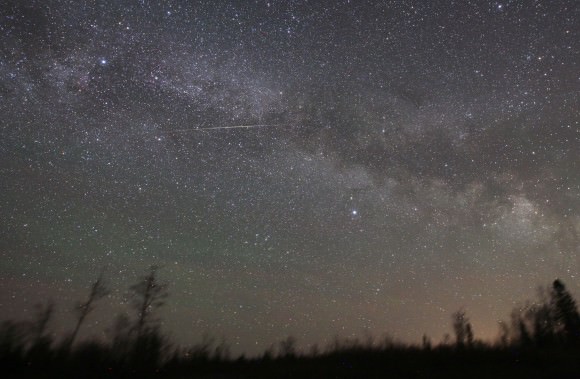
I saw 10 meteors in all, most of them slow and colorful with orange and yellow predominating. My hopes were high when the shower started with a bang. At 12:34 CDT, a brilliant, very slow moving meteor flashed below Polaris at about magnitude -1. A prominent train glowed many seconds after burnout and continued to show for more than 20 minutes in the camera and telescope. At low magnification in my 15-inch reflector (37-cm) the persistent glow looked like a brand new sausage-shaped diffuse nebula in Cassiopeia.
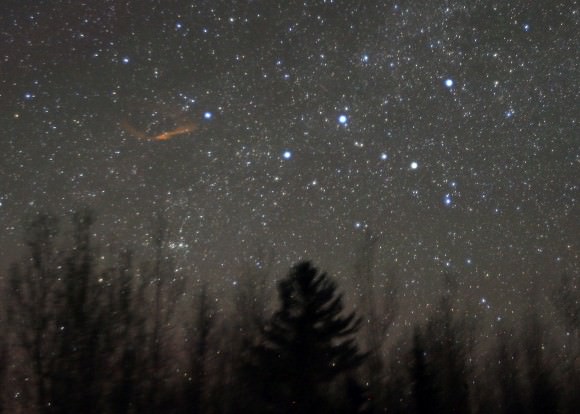
Trains form when a meteoroid’s hypersonic velocity through the upper atmosphere ionizes the air along the object’s path. When the atoms return to their rest states, they release that pent up energy as a glowing streak of light that gradually fades. The train in the photos expands and changes shape depending on the vagaries of upper atmospheric winds. Absolutely fascinating to watch.
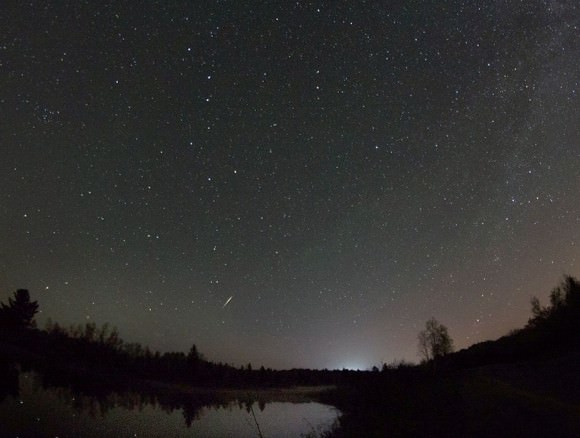
Most activity occurred between 12:30 and 2 a.m. for my time zone in the U.S. Midwest. Surprisingly, the action dropped off around 2 and stayed that way until 3. I did get one ‘farewell Cam’ on that last look up before turning in for the night.
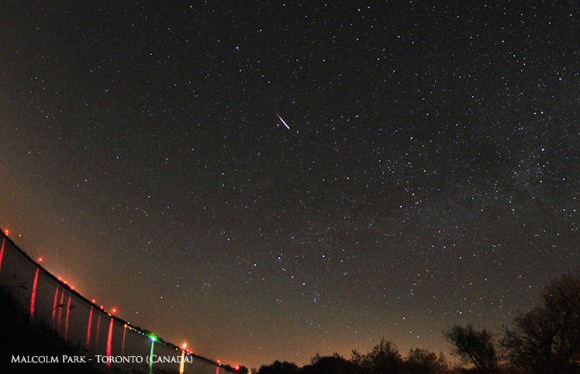
The team working with Gianluca Masi at the Virtual Telescope Project reported a number of bright meteors as well but no storm. We share several of their photos here. As more information comes in, please drop by for a more complete report. You can also check out Dirk Ross’s Latest Worldwide Meteor News for additional first hand reports.
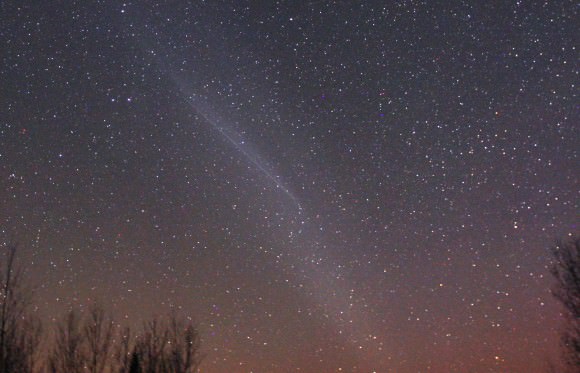
Before signing off for the moment, I’d like to ask your help in explaining a strange phenomenon I saw while out watching and photographing the shower. Around 1 a.m. I looked up and noticed a comet-like streak about 15-degrees long drifting across northern Leo. My first thought was meteor train – a giant one – but then I noticed that the center of the streak was brighter and contained a starlike object that moved in tandem with the wispy glow. I quickly took a couple pictures as the streak traveled north and expanded into a large, nebulous ray that persisted for about 1o minutes. There were no other clouds in the sky and the aurora was not active at the time.
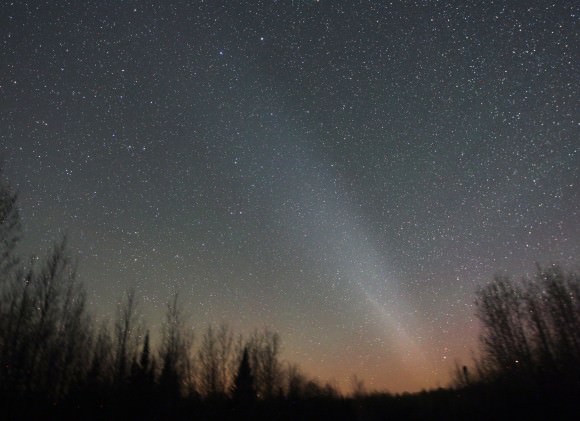
Can anyone shed light on what it was??
UPDATE: According Mike McCants, satellite tracking software developer, the plume is fuel dump connected to the launch of a new Japanese mapping satellite. One never knows sometimes what the night has in store.

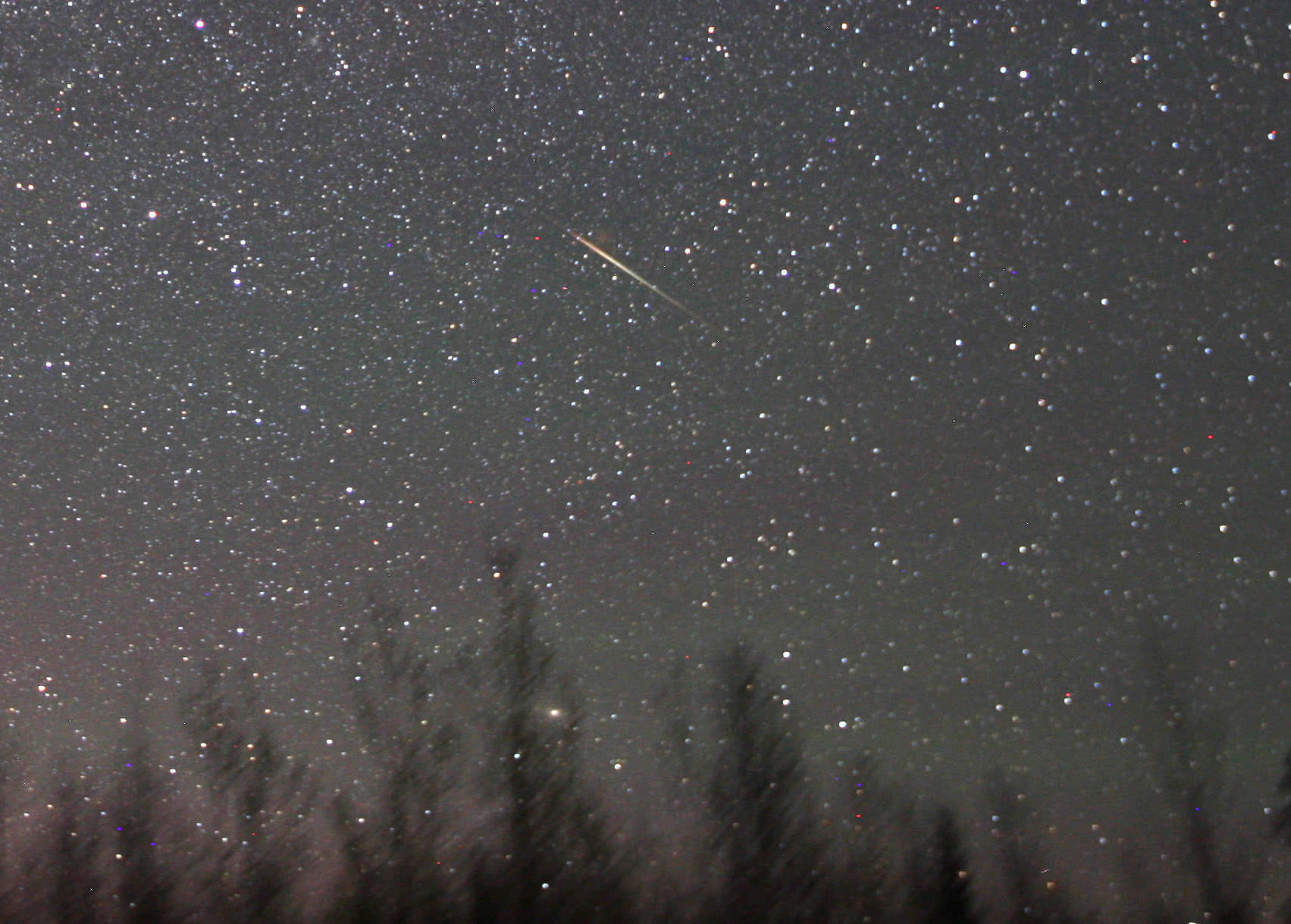
At first I thought “Iridium Flare” but as you are an experienced observer you probably eliminated that pretty quickly. There was some chatter a few years ago about something vaguely similar that turned out to be an orbiting rocket dumping fuel.
Thanks for this article. I was out from 1:45 to 2:30 ET, but didn’t see anytlhing although the sky was about as clear as it gets in my light polluted city, and my eyesight isn’t that great either.
Roger
Roger, I think you might be correct about a fuel dump. That is a possibility. Thanks for writing.
Thank you so much for this post!! You are literally the only person/news agency to report on how it went. I was a bit disappointed with my own observance last night and was curious to see what others had to say.
I was shocked to find a serious lack of information this morning when I woke. It seems every news agency went out of their way to talk about how grand this might be, but none of them cared to follow up. I commend you greatly for this post/thread. This was a bit historic, regardless 🙂 Cheers.
Thanks Schadenfreude! I appreciate that very much. Did you get to see the shower?
Thank You Bob. After a cloudy day, the sky cleared up at sunset and I got to see a couple of meteors.Even got to see the glow of the aurora on the north-east horizon for about 15 minutes.
Interesting phenomena you observed. I did see something similar as a kid, to which my mom gave me the then standard “reflections on the arctic glaciers” answer.
As for the news coverage, no doubts it would have been more comprehensive had the shower occurred over the Indian Ocean….
I live in Virginia. I actually was setting up my camera equipment around 11 pm. Somewhere between 11:20-midnight, I looked up and a gorgeous one with flared tail went across sky. It looked like a firework. Never saw anything like it rest of time I was out there. If I had waited till alleged peak time, I would have missed it.
Hi Bob: Thank you for reporting on the shower last night. I too appreciate it. My family and I were out last night in Virginia 2:15 to about 3:10 AM in a light polluted area. We saw a couple of small ones and one bigger slow one with a nice tail. Very pretty. Like you, we did see one odd thing. One star that was quite stationary suddenly began to move and then finally went back to being a stationary star. It was odd. When we first saw it it I thought it was a meteor that was coming more or less directly down towards us however it moved about at a moderate rate, never got any bigger or brighter, wandered around in sort of half square pattern then became a star again. It took about 4 minutes and no near by stars did anything like it. There were no clouds and it was not a plane nor a satellite as far as I could tell. Any idea? In any case, thank you for your reporting and great photos!
Hi Ollie,
Very interesting observation! I can’t say I know for sure what you saw but I have noticed that when I’m looking at the sky for a long time, stars can sometimes appear to wander from place. At first I think I’ve seen a faint meteor but then my eyes ‘put’ the star back in its place.
I think we also saw the object you describe. It was a little alarming at first, and did appear to have a speed that was inconsistent…slowing a bit, then speeding up, sort of shifting, several times into a quick square type pattern. For us too, it gave the impression that it was falling or dropping. Very bright. The Night Sky ap identified it as the International Space Station.. Which I was personally thrilled by! 🙂 Other than that, mostly faint, quick streakers and one nice long fireball; long, bright white and yellowish! I do wish that we wouldn’t have waited for “peak” time. We didn’t go out until almost 2:00 and stayed until 3:35 with the rising of the very large and ruddy crescent moon! By the time we packed up the four kids and got home, I was putting the baby to bed and looked up to see Venus join the moon in the pre-dawn sky. A GREAT night all around in Wisconsin!
Moongarden, the jerky movement of the space station and many other satellites is all in our eyes. We’re really seeing the jerky movement of our eyeballs as we attempt to closely track a ‘moving star’.
Thank you very much for the status report. My wife and I watched from 2:00 to 3:00 AM EDT and saw four clear, brief Cams. It was a lovely night in Canton, Ohio.
A classified NROL payload was launched Thursday morning.
http://spaceflightnow.com/atlas/av046/
We are tracking it. Perhaps this was an orbit maneuver burn. We are interested in more information about your photograph.
Apparently another possibility is the Japanese launch:
http://spaceflightnow.com/h2a/f24/140524launch/
Hi Mike,
The photo was taken about 1 a.m. CDT. The small object in the center of the cloud was about mag.3-4 and the cloud traveled from Leo Minor in the west-southwest nearly due north toward Capella.
Cees Bassa says your photo is a match for the Japanese launch.
Ted Molczan gave him your SeeSat-L email address.
Cees has just sent you an email.
Mike,
Thanks for that. Great to know it. Still no e-mail from Cees. Try this e-mail: [email protected]
Hi again Mike – I heard from Cees. Thanks very much for your help.
From Muskegon, MI…facing north looking at the North Star at approx. 3:45 EDT…I saw a bright object (sorry, I’m not a buff so don’t know the magnitude, but it was bigger and brighter than Jupiter) travel across the sky from SE to NW from when I first saw it to the East until it went out of sight to the West. It didn’t leave a trail, moved steadily, and never faded until I lost sight of it. Best estimate is it took about 40 seconds to traverse the sky. I didn’t think it could be a meteor, but there was no engine or jet sounds and that isn’t the oral path for flights over this area. It was stunning, but have no idea what it was…anyone have an idea? It was really cool and worth being up to see. I saw 5 actual meteors during the two hours. Anyone?
Sorry about the typos….*normal.
Rustleh,
My first thought was that you saw the International Space Station but it travels from west to east. If the light was steady and white (no color) then you likely saw a satellite. Many ply the skies at that hour.
Stupid me…can’t even tell directions. It did come out of the west. My only excuse is the 4 hours of sleep I lost excitedly waiting for it to start and staying up until past 4 watching. Thanks to everyone for not making too much fun. ??and thanks for the answer!
Hi. I was in the extreme northern Detroit metro area, about 35 miles from Downtown. I saw lots of lines in the sky. The yellow & orange ones were coming out of Ursa Major.Went pretty much West to East. They seemed about .25 inches long. The faint red ones, which seemed about an inch long were ‘going every which way’. Nobody else seemed to be seeing the things I was seeing, and I missed the ‘longer lines’ that passed overhead. One of the members of the Warren Astronomical Society brought his telescope, and we had an impromptu amateur sky night. What do I think was ‘wrong’ with the prediction that we “might have a spectacular show”? Nothing. Except maybe those scientists have forgotten that a good human eye is perhaps more light sensitive than a camera.
Yeah — thanks from me too; after a night filled with constantly repeated interviews with the folks who “discovered” this meteor shower, and little else — I guess everyone else is too embarrassed to show their faces, or else they’ve re-written their headlines to predict the shower will happen tonight instead!
Glad you’re in a spot with such a view, & have the ability to take such great photos, and the courage to tell it like it is, or wasn’t.
Thanks lotusgreen. I’m just going to go out on a limb here and say that the comet may not have been as dusty in the past as expected, limiting the amount of material it deposited in earlier orbits. Just a hunch.
Bob: The comet was indeed not dusty at all. In the days before this shower, some astronomers had said that they didn’t expect many of the standard small, bright, fast shooting stars because of the relative lack of dust being kicked off the comet as it orbited.
However, the comet *does* put out an unusually high number of slightly larger chucks, so they were saying that there might be a higher incidence of fireballs than normal.
I, too, managed to take some photos of the mysterious satellite surrounded by a hazy nebulousity, from here in Washington state around 12:45AM http://blog.bahneman.com/content/satellite-passing-its-own-cloud
Here on the west coast my Cams were limited to a pair of bright flares through Ursa Major between midnight and 12:30 PDT. One was especially bright, and its tail glowed much longer than anything I’ve seen from other, better known showers. It’s just unfortunate there were so few. Plenty more coming our way this year, though, so it’s all good.
Hey Bob,
I am grateful for your report, to know that I am not completely insane. I did see the objects you saw, including the anomaly. I could not make it out, but the light beams reached out quite a long distance. It appeared to be a satellite of some type, to me. I saw the 12:30 CST one you mentioned, but at PST. That one really fell apart as it came across the sky, truly amazing. One trumped that one, at about 12:15-20 PST. Very slow, and very orange. I could see parts of that one falling off. I did notice several flashes of light, like meteors moving directly downward? The concentration of that effect was at 12:35-6 PST, with about 10 total. The anomaly arrived shortly thereafter. It traveled S to N. It appeared to be a con trail or shadow, but then I traced the ray back and saw the satellite. I watched it until it went over the mountain. I was observing from Central Washington, from 10:30 to 12:50 PDT.
Thanks for solving that strange ‘cloud’ pattern that I found in my own timelapse! I put up an animated GIF on my own tiny server:
http://darethehair.duckdns.org/dmenns/mystery_animated.gif
Hey Bob, thanks for being the host for discussion about the meteor shower. I did not see any meteors down in Lakeland, Fl between 0100 and 0400 but I did see something odd around 0250 EDT. I saw several short flashes that got as bright as Venus and then disappeared quickly. I assumed that they were meteors that I was seeing “head on” but they were directly over head and closer the constellation Hercules rather than from Camelopardalid. There was another flash that I saw that was close to the constellation Draco around 0320 EDT. Did anyone else see these flashes? thanks,
Jim McGuire aka Mayhem Science Guy
I actually saw the most gigantic meteor of my life. It was so big and slow that I saw it rotate and disintegrate in an orange ball of fire, with an asymmetric tail. It utterly blew my mind. Just west of Milwaukee, WI, between 3:30 and 4:00 a.m. CST. Directly overhead. Also saw maybe 15 to 20 others from about 2 a.m. to 4:15 a.m., slow north to south. Many were faint and would not have been readily visible in an area with light pollution. Also a smattering of more typical meteors going south to north and east to west. And a crazy number of satellites. Busy skies.
Trying to get some followup on the Camelopardalids has prompted my joining this site. Thank you Mr. King, for your expert presence here, and the beautiful images!
I think I saw what rustleh saw, but with some key differences, and from the top of the Door Peninsula in WI. His time about matches mine for CDT. (I had no clock to check for sure, but I thought it was between 2:30 to 3am.) When I first saw the satellite, it was certainly negative magnitude, near the zenith, following an approximate line from Vega to Deneb. It was white. I tracked it with naked eyes or binos all the way to an extended pinky finger’s width from the horizon. It was a SW to NE track. I thought it might have been the ISS. It was much, much brighter than any other satellites I’ve ever seen. BTW, satellites beat out the meteors that night!
-DK